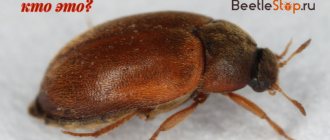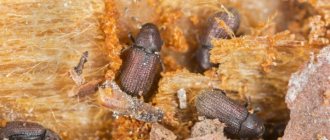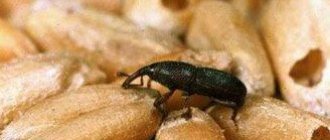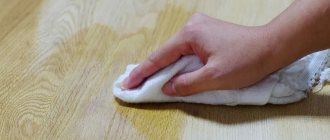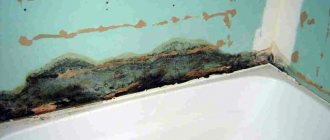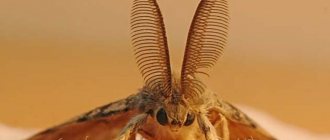Prevention in cabinets
Small bugs in the kitchen are very tenacious creatures.
Even “super housewives” are not immune from them. Small bugs in the apartment do not appear due to lack of hygiene. Pests can be introduced by purchasing already contaminated products. When choosing pasta, flour, cereals, you need to carefully examine the packaging, check its integrity and expiration date. You should not purchase bulk products with strange impurities. It is not recommended to purchase cereals by weight or from unknown manufacturers. It is better to give preference to trusted companies that use high-quality packaging.
Make yourself a rule: immediately after purchasing, place the cereal in the freezer for a couple of days.
Following these simple rules will help reduce the risk of unpleasant guests appearing in the kitchen:
- Keep nuts and dried fruits in the refrigerator, cereals in hermetically sealed containers (transparent containers).
- For storage, you can use cloth bags boiled in a strong saline solution. Cool the bags without removing them from the solution, then dry and iron with a hot iron.
- Inspect regularly and throw away expired goods.
- Monitor food storage conditions. High humidity and temperature are a favorable environment for the appearance of bugs.
- Regularly carry out wet treatment of high-risk areas using a mixture of bleach and levomycetin (half a bottle of Belizna and 20 tablets of medicine are needed per bucket of water).
- Place the borax on the shelves.
- Arrange open matchboxes. Beetles do not tolerate the smell of sulfur, so the boxes can be installed on the cereals themselves.
- Coat cracks and crevices in cabinets, floors, and window sills.
Home thermobia
In living spaces, unpleasant-looking insects called silverfish often appear and settle for a long period of time. The bugs have no wings. An oblong body with a small head with antennae and three tails in the form of processes causes outright hostility among people. They get stuck in the darkened holes in the corners. Home thermobia settles in the bathrooms of apartments and country houses, causing damage to objects and coatings.
The aerosol products produced by the current industry are suitable for exterminating all types of household pests. Useful drugs are intended as effective protection or preventive measures.
Small insects are not uncommon in the apartment. And it's not just fleas and cockroaches
But, taking certain precautions and following the clear instructions in the instructions when fighting all kinds of bugs, it is possible to achieve the desired effect, and no worms will appear in the apartment. Remember that only the owner will cope with the problem who treats the problem with full responsibility
Types of insects living in the apartment
Cockroaches and windowsill bugs are the most noticeable pests. But there are also cases when in fact there are a lot of small insects in the apartment, and their number is constantly growing, and a person simply cannot see them, since they are almost microscopic. But you definitely won’t be able to ignore the harm they cause. They can spoil fabrics, wood, paper, move food, dirt from the garbage disposal, spread infections, etc. Some small black bugs are also blood-sucking bugs that will parasitize people. In addition, they are capable of infecting people with various diseases using this method. So if there are bugs in the apartment, and a person regularly finds them, then measures must be taken to remove them.
Flea. It is a parasite that is dangerous for both humans and animals.
Here are the different types of insects that can live in a person’s apartment:
- Fleas and lice. They are parasites that are dangerous for both humans and animals. Various infections can be transmitted from them. This is how the plague spread in the Middle Ages (from). In addition, from the bites of these parasites, both the animal and the person lose blood, itching, redness and other unpleasant symptoms appear. Lice don't care who they bite; they will even attack a child. So they need to be taken out urgently.
- Grinder beetle. This is a small striped insect. It can even feed on sheets of cardboard and paper.
- Springtail. These are white bugs that can usually be found in flower pots. They feed on organic matter, so pots with soil are an ideal place for them. Small white insects can damage plant roots if their colony becomes too large. You can eradicate them with conventional drugs that are used against garden parasites. For example, Karofos and Aktara are suitable. You can also place potatoes on the surface of the soil in pots. It will attract small bugs, so the pieces need to be changed periodically to remove pests.
- Whitefly. These are white ones that can be found near plants. They harm them. They usually appear in the house from new plants. That is why they must be kept in quarantine for the first time. Whiteflies, unlike springtails, feed on stems and leaves. They can be recognized by their light-colored wings. They sit on a green plant, so they become easily visible. At all stages of their development, they suck juices from flowers. There are different varieties - tobacco, cabbage and others. To get rid of these pests, plants need to be treated with a calendula-based infusion. If the infection has already become widespread, then you need to use Aktara or Karbofos.
- Butterfly. This is a small fly that lives near the sewer. It is much smaller in size than ordinary flies. They have transparent wings with dark fringes along the edges. It is by the shape of their wings that they are easily recognized. Usually butterflies can be found in the toilet and bathroom. Larvae can develop in basements, sewers, and garbage. The flying individuals themselves prefer cabinets. They usually lay eggs in dusty cupboards or in trash bins.
- Ants. They are found in almost every home. It is very difficult to remove them from the apartment, since to do this you need to find the entire colony with the queen and the nest, and not just constantly kill the working individuals that constantly appear.
- Linen lice. They are quite rare, but their bites are quite dangerous.
- Scaleworms. These are pests of house plants. They have a white color, so they can be seen near the bushes.
Grinder beetleAnts.
These are small brown, red and black bugs. These are the most common representatives of insects that prefer to live in human premises.
The face of the enemy
The carpet beetle is a coleopteran insect. They are black or brown in color, with a body up to 12 mm long and elongated or round in shape. The bug is covered with hairs or scales.
This little parasite multiplies rapidly. And the larvae can live without food for five years.
In nature, skin beetles play the role of a recycler of dust, wool, feathers, and bones of dead animals. These are natural cleaners. Since humans are actively destroying their natural habitat, they have to move into apartments.
Uninvited guests enter houses mainly in the summer through open windows and vents. Also, household members can bring them themselves along with some things - books, carpets, furs, upholstered furniture. The parasite can also hide a newly purchased flower pot.
Carpet beetles are not at all harmless. They are harmful to human health. One bite of a small bug, and the household members have picked up some kind of viral infection or become infected with helminths. A bite can also cause an allergic reaction - unbearable itching in the bitten area.
The parasite must be removed as soon as possible. It is necessary to destroy not only the bugs themselves, but their caterpillars and all larvae.
Methods to combat silverfish
If you see these long insects in your own bathroom, take immediate action. There are several ways to remove silverfish. Let's look at each of them.
Method 1. Physical
To get rid of white bugs, create conditions for them that are unacceptable for life. Carry out a general cleaning in the bathroom - wash away the dirt and hard deposits that have appeared under the sink, toilet, bathtub and near the water supply. Add any product containing chlorine to the washing water. As soon as this layer dries, treat the surfaces with a solution of copper sulfate. After waiting a few hours, you can wash the floor again.
As for high humidity, you can reduce its level with special heaters or thorough ventilation (especially after taking a bath or shower).
Method 2. Insecticidal
To combat silverfish, chemical aerosols intended for baiting household parasites are also suitable. You will have to use them for at least a month, performing treatment once a week.
Some of the most popular and effective aerosols include the following:
- Raptor;
- Mosquitall;
- Combat;
- Antimol;
- Dichlorvos;
- Raid;
- Clean house;
- Armol;
- Extramit.
When performing treatment, close the windows and doors, wait the time specified in the instructions, and then ventilate the room and carry out wet cleaning. Wash especially thoroughly those surfaces that come into contact with your hands.
Method 3. Lures and traps
If you are bothered by transparent bugs in the bathroom, use special traps against them. Ideal for these purposes:
- Wet birch brooms - just place them in the corners and leave them overnight. In the morning they must be carefully taken out of the room and thrown into a trash bin or burned;
- Glass baits. Wrap the outer surface of the jar with tape or paper - the rough surface will allow the insect to easily get inside, but will not be able to get out. To be safe, place a piece of sweet fruit, a handful of sugar or a couple of berries on the bottom;
Paper. Dampen a roll of paper napkins or toilet paper and leave it overnight. Silverfish love moisture, so they will definitely climb into this shelter. In the morning, you need to burn it or throw it away without unwrapping it.
Wet paper serves as food for silverfish, so this bait is quite effective and can quickly rid you of insects
Method 4. Folk remedies
Small white insects have been known for a long time, so humanity has managed to find several recipes that will quickly and safely solve this problem:
In dark corners, under baseboards, between floor tiles and in cabinets, sprinkle diatomaceous earth, a special food powder that kills crawling parasites;
- Lay a path of ground zest - silverfish cannot tolerate its aroma. After 5 days, update the protection;
- Dust the room with spices - especially white bugs do not like the smell of cloves;
- Wash all surfaces with water and lavender or citrus essential oil;
- Sprinkle a mixture of boric acid (1 part) and chalk (4 parts) near the pipeline, as well as around the toilet and sink. Leave them for a week and then update.
Ways to enter the house
Small black bugs or their brown counterparts can get into the home in one way - they are brought in with food (usually flour or cereals). Initially, pests infest cereals in production, the reason for this is non-compliance with storage conditions or violation of technical conditions during production. Due to poor quality processing of grain during the production of cereals, it becomes infected.
Bread affected by bread grinders
Bugs also appear in the kitchen if you buy a loose product. They can start under the conditions that were discussed above, however, insects move to clean cereals from a nearby uncovered container with loose product.
When the degree of contamination of food with insects is high, it is better to throw away such cereals and not eat them.
If a bug was found in flour, rice, or millet, it means that pests have already been there and probably multiplied. By consuming such a product, a person risks being poisoned, since insect excrement remains in the contaminated cereal. Such food is not beneficial for another reason - there are practically no nutrients left in it.
How to get rid of bugs in cereals in different ways
If pests are found in cereals or other products, you need to start fighting them immediately. The simplest way is to dispose of spoiled food. You should pour everything into a bag, tie it tightly and place it in another one of the same kind.
When bugs in cereals have become a real problem and are not eliminated by throwing away the affected products, you have to resort to radical measures.
If there are insects in cereals, one folk recipe for homemade bait will help:
You will need borax or boric acid, semolina and powdered sugar. Mix everything in equal quantities. Sprinkle the resulting mixture on all horizontal surfaces
Particular attention should be paid to the place where the pests were found. Small insects do not tolerate sudden temperature changes, frost and heat
If you find pests in winter, it is enough to take the cereals out onto the balcony. But at the same time, the mercury column should show no higher than -15 °C. After a couple of hours, all insects will die. This method is especially relevant in order to remove beetles that have taken up residence in flour or semolina, but at the same time preserve food
Small insects do not tolerate sudden changes in temperature, frost and heat. If you find pests in winter, it is enough to take the cereals out onto the balcony. But at the same time, the mercury column should show no higher than -15 °C. After a couple of hours, all insects will die. This method is especially relevant in order to remove beetles that have taken up residence in flour or semolina, but at the same time preserve food.
For cereals, the opposite method is suitable - exposure to heat. Pour the product onto a baking sheet and place it in the oven. At a temperature of 50 °C, the uninvited “tenants” will die within 15 minutes. But to be sure, they recommend holding it for 30 minutes.
When there is no time or suitable conditions, an alternative option is suitable: take the amount of cereal needed for cooking and add hot water. This method is suitable for quickly ridding pasta and bulk food products of most small insects. The pests will float up dead, just drain them and repeat the procedure.
Washing cereals with salted water gives good results. All pests float to the surface, but after this you need to repeat the procedure with regular liquid without impurities. The method is even suitable for oatmeal, but it must be cooked immediately.
Table vinegar
Used for wet cleaning after getting rid of insects. The pungent odor of the substance will protect against new pests and drive away those remaining after persecution. Surfaces are treated with a solution of laundry soap, vinegar essence and boiling water.
Strong odors
All insects are afraid of strong odors. They are not able to destroy pests, but will drive them away for a while. Garlic, bay leaves, dry lavender, wormwood and sage will cope with this. The herbs are laid out after thorough wet cleaning in the former habitats of the bugs.
Insecticides in the form of emulsions and aerosols are sprayed in rooms from which all products have already been removed. The procedure is usually carried out as one of the points in a comprehensive pest persecution plan. After treatment, it is forbidden to stay in the room for some time if it is not ventilated, but food cannot be stored for even longer.
The only substance of this type that is relatively safe for humans is Pyrethrum. The natural insecticide is based on Dalmatian chamomile and is often used to treat indoor plants.
Why is a little bug dangerous?
Bugs appeared in the apartment - all the residents lost peace. Unknown creatures create fear; it is unclear what can be expected from them. The damage caused by bugs in an apartment consists of damage to property and food. They can ruin expensive interior items, books, chew carpets, and fur products. The fur coat is especially affected. Sacks, packages, poorly closed jars of cereals, flour, and drawers are being found in the kitchen. They can live in cabinets, bread bins, and on shelves. Of course, the cereal can be cleaned of bugs and larvae removed. But the eggs remain.
The excrement of bugs poses a particular danger to humans. When ingested along with food, they cause allergies. It is difficult to predict the reaction. This may be ordinary redness, a rash on the skin, or attacks of choking, coughing, or signs of poisoning. There is no need to be afraid of bites from small bugs. Human skin is of no interest to them. Although, judging by the name, one might suspect this.
Larvae spoil natural things in the same way as moths. Gnawing holes, cutting off lint. Without seeing an adult bug, you might think that a moth is operating. Control measures are similar, but have their own characteristics.
Harm
Anthrenuses and leather beetles damage food, things, furniture, fabrics (not only wool), leather goods, books, and carpets. Insects chew through drywall, wooden furniture, even electrical wiring. Omnivorous insects live not only in the kitchen: pests crawl throughout the apartment.
Small brown beetles carry dangerous disease pathogens on their tiny legs and antennae. Insects move through dusty corners, food waste, the bathroom area, move into the kitchen, and crawl on food. It is difficult to talk about maintaining hygiene standards after such “travels”.
Types of grinder beetles and their characteristics
Many people don't even realize how harmful this insect is. Depending on the type of insect, the damage they cause to a person’s home can be different, but serious. In the photo you can see the borer beetle, as well as certain species of this harmful insect.
Furniture sharpener
This is an insect that grows up to 5 mm in length, which is distinguished by a dark brown body color, with golden splashes that are clearly visible on the back. It feeds on and processes any type of wood, which poses a serious danger. It is found mainly in home furniture, but in certain conditions it does not refuse the walls of a wooden house. In addition, it can ruin any product that contains cellulose. These are picture frames, books, cardboard, as well as wood products that are of interest to the pest.
It is very difficult to detect the pest, because at the slightest danger it hides and freezes for a while. The fact that wooden structures are affected by a furniture grinder can be understood by the presence of small holes in the wood, as well as yellowish dust that spills out of these holes. In these holes, after some time, the female lays eggs, from which rather voracious larvae will subsequently be born.
House grinder
This type of pest prefers damp wood rather than dry wood, so it is more often found outdoors rather than indoors. The house grinder grows up to 5-7 mm in length. In the photo below you can see what a wood-boring beetle looks like.
Common comb grinder
You can distinguish this pest from its relatives by its unique mustache. Grows to sizes 3-5 mm. If this beetle penetrates into the thickness of the wood, it will not leave it until only dust remains of the wood.
Bread grinder
This pest does not sharpen wood, but renders dry food products, such as cereals, grains, pasta, including dried fruits, unusable. In this regard, we can safely say that the bread grinder poses a serious threat to humans. It can easily leave a person without food if their condition is not controlled.
Black house beetle
This type of pest prefers dry coniferous wood, so it cannot be found in living trees. The female lays eggs under the bark of dried or cut down trees in the warm season. Therefore, the black longhorned beetle enters a person’s home along with firewood or building materials that have not undergone special treatment.
Where do they come from
In addition to the fact that insects enter through open windows or vents and all sorts of cracks in them, there are several other ways for skin beetles to enter an apartment. Let us briefly outline the paths of saboteurs:
- purchasing new products already infected with bugs;
- on the body of pets after a walk;
- ventilation ducts.
In any case, you need to be careful and careful.
When the owners notice that black beetles have appeared in the room, despite the fact that there is no disorder in the room and the cleaning was carried out on time, the question immediately arises where they could come from.
Ways of appearance of beetles in an apartment:
- cracks in walls, window frames, into which small insects can easily crawl;
- ventilation shafts and openings in which protective nets are not installed;
- windows and vents, open for ventilation, can become an “entrance door” through which flying insects fly into the apartment;
- through risers of sewer and water pipes;
- black beetles appear in apartments in the summer, clinging to people’s shoes or clothes, thus penetrating the living rooms and kitchen;
- from a neighboring basement or attic.
Fighting methods
What to do if bugs still appear in flour and cereals?
Disposal
The main method of combating the bug is the disposal of affected supplies. Of course, it’s a great pity for spoiled flour or cereal, but if there are insects in it, it means that a couple more days will pass and they will crawl throughout the house. Therefore, it is urgently necessary to tie the bag tightly and put it in another bag and take it to the trash.
After disposal, it is necessary to wash kitchen shelves and cereal storage containers (if any) with bleach, soda or vinegar. After treatment, be sure to rinse the surfaces with water.
Heat treatment
All types of insects die at temperatures above +50 degrees. This can be either boiling water or steam treatment. This method is good for eliminating bug nests in baseboards and crevices that cannot be reached with chemicals and sanitation.
To remove bugs directly from cereals, you can fry them in the oven at a temperature of about 50-70 degrees for 20 minutes. Or put it in the freezer for several hours. Insects die at temperatures below 15 degrees.
When the larvae and adults are destroyed, it is necessary to thoroughly rinse the grains (beans, beans, nuts) with water and wait for the pests to surface. Then, drain the water and rinse the product again so that there are no larvae left in it. After heat treatment, it is better to sift flour and small grains through a sieve 2-3 times.
Chemicals
On open kitchen surfaces, it is better to use special chemicals, which are sold in abundance in hardware stores. Just don’t buy simple remedies for cockroaches and ants to fight the bug. In this case, specialized products are needed, for example, “Antizhuk” or “Karbofos”.
“Anti-bug” helps in the fight against any bug, be it cereal or wood, that damages windows and furniture. The drug is quite effective, but be sure to read the instructions before use, as it is toxic.
To remove insects, you can use “Rogneda” - a powerful antiseptic that can destroy weevils, mucoeds, as well as ants and cockroaches.
Another effective remedy is Lovin Fire Protection. The drug kills the beetle in the shortest possible time, but it must be scattered in places inaccessible to animals, as it is a powerful poison.
Folk recipes
Recipe 2.
Mix boric acid, flour and powdered sugar in equal proportions, which serves as an excellent bait. Scatter the mixture in the habitats of the bugs.
Recipe 3.
Insects are afraid of the smell of bay leaves, garlic, pepper and sulfur. It is enough to put a sprig of bay leaves in the kitchen cabinet or lay out simple matches, and reliable protection against pests will be created.
Simple precautions will help you avoid such an unpleasant problem as kitchen pests
- To prevent bugs from infesting flour and cereals, they must be stored at medium humidity in a well-ventilated area;
- You need to make sure that there are no raw or undried foods (dried fruits, vegetables, wet cereals) in the kitchen cabinets. If there are any, then the mucoed will definitely settle in them;
- It is mandatory to regularly inspect products and shelves. Make sure that cereals do not sit for a long time; long-term storage is the main cause of insects.
- Keep cloves, bay leaves and matches in your kitchen cupboard to repel pests.
- Store cereals and grains in plastic or glass containers with an airtight lid.
- If you notice the first signs of spoilage of food, immediately throw it away or rinse or sift through a sieve.
- Carry out general cleaning at least once a month using disinfectants.
The appearance of insects in cereals and flour is a nuisance that many women face. Beetle larvae are very indiscriminate in their food supply and can damage food and even non-food supplies. You should get rid of pests immediately, as they can spoil a large supply of provisions. Their waste products are toxic.
Mucoeds
They are polyphagous beetles, that is, their menu is very diverse. Three types can be found in apartments.
Surinamese
A beetle 3-3.5 mm long with a red-brown back. The pest is flat, very elongated in length, with a thin body. The pronotum has characteristic longitudinal “ribs”.
Prefers bakeries as a bottomless source of nutrition. But often, along with flour and cereals, it gets into apartments, where it infects other supplies. The vital activity of bugs leads to an increase in humidity in products, which is why mold forms in cereals.
Maximum lifespan 3 years. Usual 6-10 months. The life cycle is 27-51 days at a temperature of 29-35°C.
Red mukoed
The light brown beetle is approximately 2 times smaller than its Surinamese “brother”. In the apartment, the food supply, habitats and life cycle are similar to those of the Suriname mucoedeater. A distinctive feature of the red mucous eater is inactivity.
Mucoeds
Merchant beetle
A flat small beetle, 2.5 cm long. Almost completely identical to the Surinamese beetle in morphology and lifestyle, differing in eye size and head shape. The bugs crawl actively, moving to new habitats.
Fleas: danger, biology, specifics of control
Fleas are another biting parasitic insect in the apartment. They spend most of their time in shelters near the resting places of domestic animals, often spending a long time in the fur of cats and dogs. The larvae of these small blood-sucking insects can be found in any place where there are rotting organic remains: in garbage, sewers, animal bedding.
Adult fleas feed exclusively on the blood of humans and animals. But their larvae can eat both food products and the excrement of adult fleas or pets.
All the difficulties of fighting fleas are related to the fact that they can be found both in the fur of animals and anywhere in the room. Of all the insects that live in an apartment, fleas require the most comprehensive approach when removing them: they are first destroyed on animals, then indoors, and finally the surviving larvae are poisoned.
Woodlice
These insects have an oval body of light gray, white, beige or brown, convex on top, and consists of several segments.
The bug has 7 pairs of legs and a hard shell, and in front there are antennae up to half the length of the body. In nature, woodlice love damp places, which is where they got their name, but sometimes they settle near human habitation. They can climb into the cellar and into some rooms in the house (bathroom or toilet) where there is high humidity. Penetrating into living spaces, woodlice can not only frighten people who are disgusted by insects that run quickly, but due to moisture and mold they become carriers of various fungal diseases, which pose a danger to human health.
Therefore, it is imperative to combat such moisture-loving insects, taking all possible measures to destroy them.
What are the different types of kitchen pests?
Types of bugs that live in the apartment
The bugs that attack supplies in the apartment are generally similar to each other. They are all small, their colors range from red to dark brown and black. Taste preferences differ slightly: some love flour and small cereals, while others will not refuse beans, cookies and even wood.
There are a lot of insects living in apartments. The most common among them are:
- Red flour eater. Tiny bugs, not exceeding 2 mm in length. They are light brown or red in color and have hard wings. Their small white larvae are almost invisible in dry bulk products. Cereals and flour where such pests have appeared must be thrown away.
- Flour beetle. The bugs are brown in color, with antennae 2-3 mm long. The foods they eat clump into clumps.
- Bread grinder. Especially voracious brown insects that live in kitchen apartments are covered with shaggy hairs. Their body is no more than 4 mm in length.
- Food moth. Adult representatives of these small insects in the kitchen reach a length of 1 cm. Most often they settle in pasta, cocoa, tea, and do not refuse to eat dried fruits.
- Granary weevil. The beetles are dark brown in color with defective wings. They grow no more than 4 mm in length. On the front of their head they have a protrusion that resembles a long proboscis.
- Grains. Black insects with yellowish legs and antennae. They have spots on the back and elytra.
- House ants. Unlike forest ones, these are very small brown ants in the apartment.
- Common silverfish. In everyday life it is called a sugar bowl; this insect has a flat body, tapering towards the end.
Whatever type of pest is found in the dining room, it must be dealt with. The longer you ignore the appearance of insects in your apartment, the more they will multiply, spoil more food, and the more difficult it will be to destroy them. Therefore, having met one representative of this species, it is necessary, without delaying until tomorrow, to take decisive action.
Favorite habitat of insects
Insects in the kitchen love to live in cereals and flour
Kitchen pests thrive in temperatures between 15°C and 30°C.
The red flour eater likes flour and small cereals, such as semolina, corn, wheat, and barley. He also does not refuse rice, buckwheat, cookies, crackers, and compote mixture. The flour beetle loves to live in flour or starch. As they multiply, the insects take over new territories and move into other finely ground grains.
The bread grinder prefers loose leaf tea, instant coffee, beans, peas, nuts, and tobacco as food. Besides food, he loves wood from kitchen cabinets and book pages.
Granary weevils most often attack rice, wheat, barley, and rye. Much less often, insects in the kitchen settle in corn, buckwheat, flour or pasta.
Caryopsis attacks legumes: peas, beans, beans.
Sugar silverfish live in dark, warm, damp places. The bathroom is well suited for this. She feeds on sugar, flour, glue, and wet paper.
Pet food bags are also suitable habitats for most kitchen pests, so they should be tightly sealed and kept in a cool, dry place.
Damage caused by bugs and danger to human health
Indoor insects lay larvae and leave excrement in the food in which they live. If all this gets into the human digestive tract, he will become poisoned. Therefore, if you find at least one pest in a container with cereals, all its contents must be thrown away. To think that a single guest wandered here by chance is a big misconception. While the adult kitchen parasite is difficult to see, its white or transparent larvae are even more difficult to discern with the naked eye.
Who are skin beetles?
Specialist coleopterologists classify this small insect as a member of the order Coleoptera. It has a brown sometimes black color. The insect is small oval in shape. The entire body is covered with short, stiff hairs.
Brown beetles are divided into four large classes, each of which contains from two to eight species. According to this classification, there are more than 600 species.
Types of bugs, what do they eat?
The following types are most common in apartments:
- ham (the most common is almost black in color);
- carpet (uses organic compounds);
- fur coat (has a black color with several white dots on it. Prefers crumbs, food scraps, table waste. The adult lives using accumulated nutrients);
- Kozheed Smirnova (brown in color. Settles in wooden structures: door and window frames, wooden floors and wall decoration, in furniture elements);
Any household items serve as a breeding ground for them: from organic compounds (leather goods, fabrics, books, furniture, carpets, waste products) to synthetics.
The diet includes: cardboard, felt, rubber, cable braid, asbestos structures. Capable of eating indoor plants and flowers. They can cope with almost all plant foods.
The grain beetle is capable of destroying nuts. Various types of grains and cereals, bran flour and products made from them. Ham specializes in meat and fish products.
Let's celebrate! Despite this omnivorous nature, small brown bugs are able to go without food for a long time. It has been established that this period can last up to five years. In this case, their biological processes slow down, but they remain viable.
